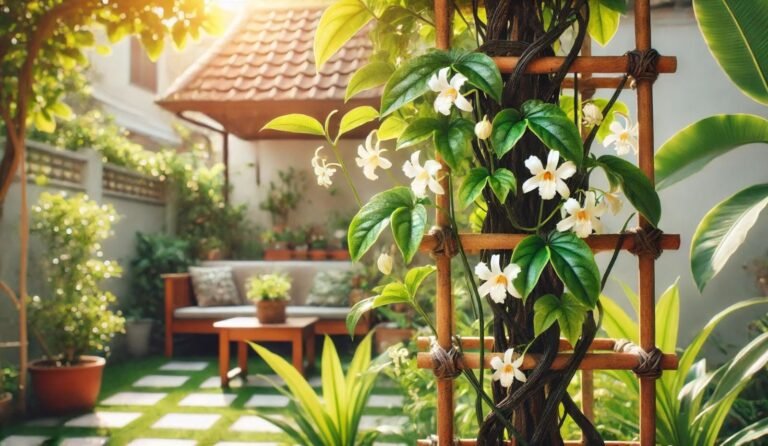Jersey Blueberry Plant: How to Grow & Care for Huge Harvests
The Jersey Blueberry Plant is a backyard gardener’s dream—easy to grow, loaded with sweet berries, and tough enough to handle cold winters. Whether you’re craving fresh blueberries for pancakes or a beautiful, fruit-bearing shrub in your yard, this plant delivers.
It thrives with minimal effort, but a little know-how can take your harvest to the next level. Want bigger, juicier berries? Curious about the best soil, watering tricks, and pruning hacks? Stick around—this guide has everything you need to grow a thriving Jersey Blueberry Plant!
What is a Jersey Blueberry Plant?
The Jersey Blueberry Plant (Vaccinium corymbosum) is a Northern Highbush blueberry variety that has been a favorite among growers for decades. This plant is well-known for producing small to medium-sized, sweet berries that ripen late in the season, usually from mid to late summer. One of the standout features of the Jersey Blueberry Plant is its hardiness.
It thrives in USDA zones 4-7, meaning it can tolerate cold temperatures better than many other blueberry varieties. The plant itself can grow up to 6-8 feet tall, making it an impressive addition to any garden. Another advantage of the Jersey Blueberry Plant is that it is self-pollinating.
This means you don’t necessarily need multiple plants for it to bear fruit. However, planting it near other blueberry varieties—such as Bluecrop or Duke Blueberries—can significantly increase yield and improve fruit quality.
Why Choose Jersey Blueberry Plants for Your Garden?
If you’re wondering whether the Jersey Blueberry Plant is the right fit for your garden, let’s go over some reasons why this variety is a great choice:
High-Yielding: Once mature, this plant produces an abundance of blueberries year after year.
Cold-Hardy: Unlike some varieties that struggle in colder climates, the Jersey Blueberry thrives in zones 4-7 and can withstand chilly winters.
Low-Maintenance: It requires minimal care, making it ideal for beginners.
Long Lifespan: With proper care, a Jersey Blueberry Plant can live and produce fruit for decades.
Nutrient-Rich Berries: Blueberries are packed with antioxidants, vitamins, and minerals, making them a healthy snack.
With these benefits, it’s no surprise that so many home gardeners love growing Jersey Blueberries!
How to Plant Jersey Blueberry Plants

Choosing the Right Location
The success of your Jersey Blueberry Plant starts with choosing the right location. Blueberries need full sun to produce the best fruit, so pick a spot in your yard that receives at least 6-8 hours of direct sunlight per day.
In addition to sunlight, soil conditions play a crucial role. Blueberries thrive in acidic soil with a pH between 4.5 and 5.5. If your soil is too alkaline, you can lower the pH by adding peat moss, sulfur, or pine needles.
Preparing the Soil
Before planting, it’s a good idea to test your soil pH using a soil testing kit. If the pH is too high, you can make adjustments by mixing in acidic organic matter such as:
- Peat moss
- Pine bark
- Composted leaves
Additionally, ensure the soil is well-draining. Blueberries dislike “wet feet,” meaning they do not tolerate waterlogged soil. If your soil retains too much water, consider planting blueberries in a raised bed or container.
Planting Steps
The best time to plant Jersey Blueberry Plants is in early spring or fall. Follow these steps for successful planting:
- Dig a hole that is about twice as wide and deep as the root ball.
- Mix some compost or peat moss into the soil to improve drainage and acidity.
- Place the plant in the hole, ensuring that the root crown is level with the soil surface.
- Backfill the hole, gently pressing the soil down to remove air pockets.
- Water thoroughly to help the roots settle.
For multiple plants, space them about 4-6 feet apart to allow proper air circulation and growth.
Caring for Your Jersey Blueberry Plant

Once your Jersey Blueberry Plant is in the ground, caring for it properly will ensure healthy growth and a bountiful harvest.
Watering Requirements
Blueberries require consistent moisture, especially during the growing and fruiting seasons. Provide 1-2 inches of water per week, either through rainfall or manual watering. To retain moisture, consider adding a layer of mulch around the base of the plant. Organic mulch such as pine needles, wood chips, or sawdust will not only help with moisture retention but also help maintain the acidic soil conditions blueberries love.
Fertilizing Your Blueberry Plant
To encourage healthy growth, fertilize your plant with an acid-loving plant fertilizer in early spring and again in late spring. Avoid fertilizers high in nitrogen, as they can cause excessive leafy growth at the expense of fruit production. Some great fertilizers for blueberries include:
- Ammonium sulfate
- Cottonseed meal
- Fish emulsion
Pruning for Maximum Yield
Pruning is essential to keep your Jersey Blueberry Plant healthy and productive. The best time to prune is in late winter or early spring, before new growth starts. Remove any dead, diseased, or weak branches, as well as older canes that no longer produce fruit. This encourages new growth and better airflow, which reduces the risk of fungal infections.
Common Pests and Diseases & How to Prevent Them
While Jersey Blueberry Plants are generally disease-resistant, they can sometimes be affected by common pests and fungal infections.
Common Pests
Birds – Use netting to protect ripening berries.
Aphids & Mites – Spray with neem oil or insecticidal soap.
Common Diseases
Powdery Mildew – Ensure good airflow and avoid watering the leaves.
Root Rot – Prevent by planting in well-draining soil.
Keeping your plant healthy, well-spaced, and properly pruned will minimize most disease and pest issues.
Harvesting Jersey Blueberries
The Jersey Blueberry Plant produces fruit in mid to late summer. You’ll know your berries are ripe when they turn a deep blue color and easily come off the stem. Avoid picking them too early, as unripe blueberries can be sour. To harvest, gently roll the berries off the stem with your fingers. Be careful not to crush them, as they are delicate. After harvesting, store blueberries in the refrigerator for up to two weeks, or freeze them for longer storage.
Can You Grow Jersey Blueberry Plants in Containers?

Absolutely! If you don’t have a garden or live in an apartment, Jersey Blueberries can thrive in pots. Use a large container (at least 12-16 inches in diameter) with well-draining, acidic soil.
When growing in containers:
- Place in a sunny spot (balcony, patio, or near a window).
- Water frequently, as pots dry out faster than garden soil.
- Protect from winter cold by moving the pot indoors or insulating it.
FAQ
What is a Jersey Blueberry Plant?
The Jersey Blueberry Plant (Vaccinium corymbosum) is a Northern Highbush variety known for its sweet, small-to-medium-sized blueberries and cold-hardiness.
How tall does a Jersey Blueberry Plant grow?
It typically grows 6-8 feet tall, making it a great addition to home gardens.
Is the Jersey Blueberry Plant self-pollinating?
Yes, but it produces more fruit when planted with another variety like Bluecrop or Duke Blueberries.
What are the best growing zones for Jersey Blueberries?
Jersey Blueberries thrive in USDA Zones 4-7, tolerating colder climates well.
How much sunlight do Jersey Blueberry Plants need?
They require at least 6-8 hours of full sun per day for optimal fruit production.
What type of soil is best for Jersey Blueberry Plants?
Blueberries need acidic soil with a pH of 4.5-5.5 and well-draining soil enriched with organic matter.
How often should I water my Jersey Blueberry Plant?
Water 1-2 inches per week, increasing during fruiting season to prevent dry soil.
When should I fertilize my Jersey Blueberry Plant?
Use an acid-loving fertilizer in early spring and again in late spring.
Final Thoughts
Growing Jersey Blueberry Plant is a rewarding experience that brings fresh, homegrown berries right to your table. Whether you plant them in your backyard or a container, these hardy bushes will provide you with delicious blueberries for years to come—all with minimal maintenance. Now that you know how to plant, care for, and harvest Jersey Blueberries, it’s time to start your blueberry-growing journey! Happy gardening!







